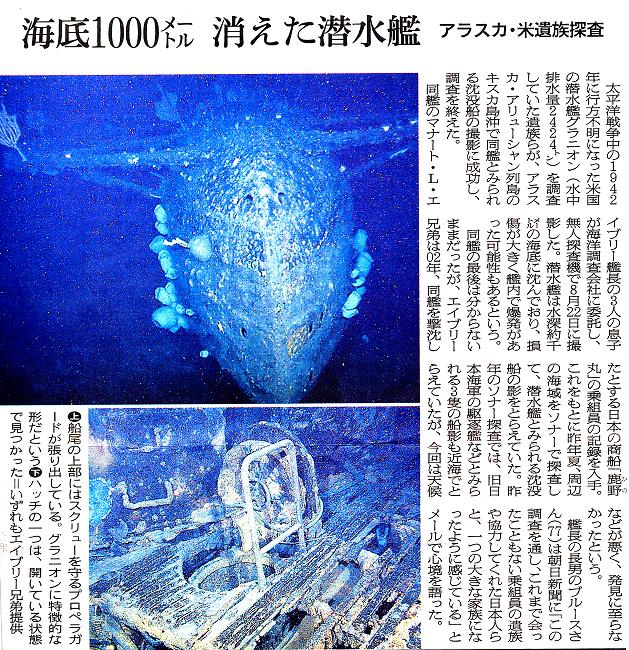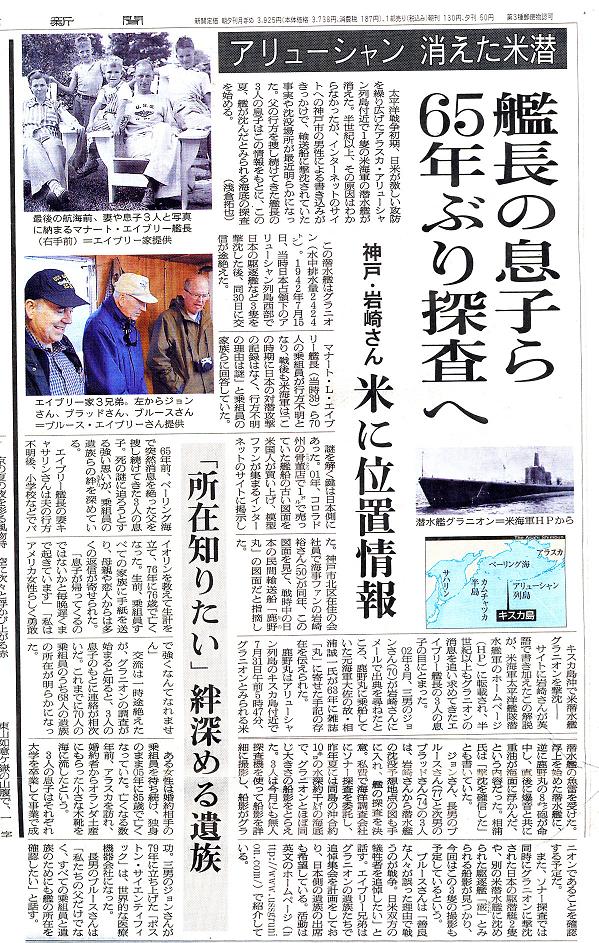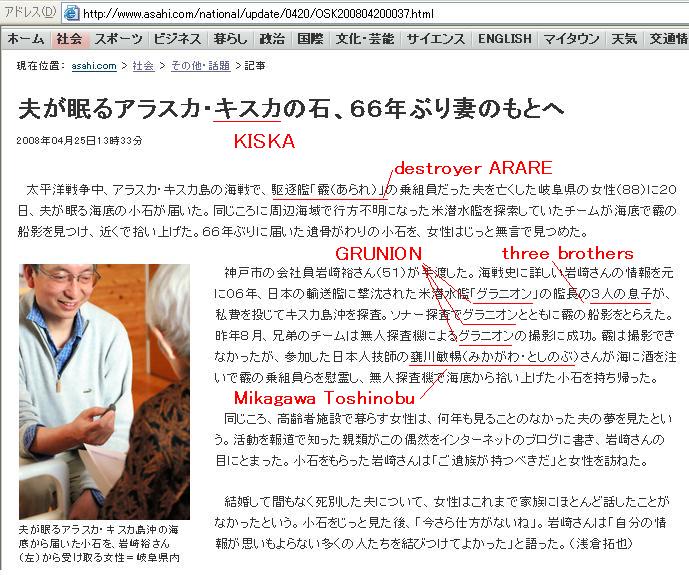 |

return
 |

65年前消えた米潜、遺族探査へ 神戸からネット情報2007年08月17日03時02分
太平洋戦争初期、日米が激しい攻防を繰り広げたアラスカ・アリューシャン列島付近で1隻の米海軍の潜水艦が消えた。半世紀以上、その原因はわからなかったが、インターネットのサイトへの神戸市の男性による書き込みがきっかけで、輸送船に撃沈されていた事実や沈没場所が最近明らかになった。父の行方を捜し続けてきた艦長の3人の息子はこの情報をもとに、この夏、艦が沈んだとみられる海底の探査を始める。
| An Internet post from Kobe Helps Bereaved Family in Search for US Sub That Disappeared 65 Years AgoIn the early days of the war in the Pacific, a US Navy submarine disappeared near Alaska’s Aleutian Islands, where the US and Japan were engaged in fierce combat. For more than 50 years, no one knew what had happened to the sub, until an internet posting from a man in Kobe led to the discovery that the sub had been sunk by a transport freighter, as well as the sunken sub’s location. Working with this information, the 3 sons of the submarine’s commander, who have been searching for years for their father, will visit the site this summer to begin exploration of the ocean floor.The submarine was the USS Grunion (2424 tons displaced when submerged). On July 15, 1942, the Grunion sank 3 Japanese sub-chasers and other vessels in the west Aleutian Islands (which were occupied by Japan at the time). After July 30th, however, communication from the Grunion stopped abruptly. Commander Mannart L. Abele (aged 39 at the time) and his crew, 70 men in total, were listed as missing in action. After the war the Navy told the families of the crew that since there were no Japanese records of sunken submarines for this period, they had no explanation as to the whereabouts of the Grunion or her crew. The key to the mystery ultimately came from Japan. In 2001, at an antique store in Colorado, an American purchased, for $1, an old drawing of a war ship. He uploaded the image onto a website frequented by model shipbuilding fans. That same year, Mr. Yutaka Iwasaki, a 50-year-old company employee and Japanese navy buff living in Kobe’s Kita-ward, recognized the war ship as the Japanese freighter Kano-Maru. “US submarine Grunion sunk in Kiska Harbor…” Mr. Iwasaki’s comments, written in English, were forwarded to the United States Pacific Fleet Submarine Force website, and found their way to Commander Abele’s 3 sons, who had been searching for the Grunion for over 50 years. In March 2002, Commander Abele’s youngest son John (aged 70) mailed Mr. Iwasaki to enquire as to the source of his information. Mr. Iwasaki directed him to a Maru magazine article from 1963 written by the late Mr. Sei-ichi Aiura, a Japanese navy captain who had been on board the Kano-Maru. According to the account, at 5:47am on July 31, the Kano-Maru, located near Kiska Island in the Aleutians, was torpedoed by a submarine, thought to be the Grunion. As the submarine was beginning to surface, an 8-cm shell fired from the Kano-Maru hit it directly, and this was followed immediately afterward by an explosion and the appearance of fuel oil on the ocean surface. Aiura confirmed that the submarine had sunk. Having procured from Mr. Iwasaki a map indicating the location of the sunken submarine, John and his older brothers Bruce (77) and Brad (74) decided to search for the vessel. Leasing sonar search technology from a marine survey firm, last summer they found, at a depth of 1000 meters, 10km from Kisco Harbor, an outline of a ship roughly the same size as that of the Grunion. This month, the brothers plan to revisit the site, take detailed photographs of the image using a remote-operated vehicle, and confirm that the image is indeed that of the Grunion. Last year’s sonar exploration also found outlines that may be those of the 2 Japanese sub-chasers sunk by the Grunion, as well as Japanese destroyer Arare, which was sunk by another US submarine. Bruce comments, “Wars are fought by good people for the wrong reasons. We should remember both US and Japanese victims.” The Abele brothers are planning a memorial ceremony for the families of the Grunion crewmen, and welcome attendance from bereaved families from Japan as well. The activities of the Abele brothers are detailed on their homepage. Asahi Shimbun, August 16, 2007. |


|